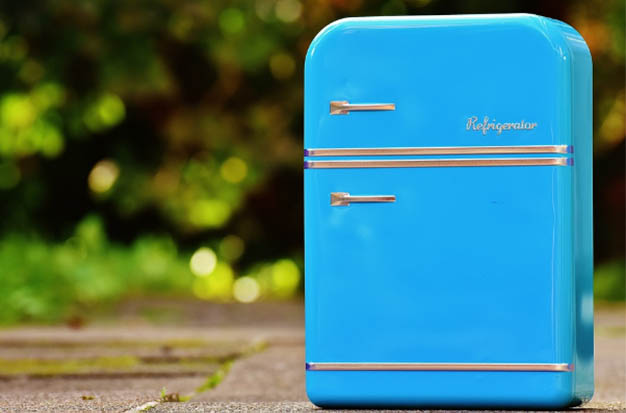
How to Transport a Mini Fridge In Simple Ways?
Moving a fridge is difficult and will not be made any easier by a magic formula. In addition to being heavy and large, refrigerators are also expensive. Knowing how to move a refrigerator safely, however, will make the task much simpler.
Depending on your circumstances, it might be best to occasionally let the experts handle this task. If that isn’t an option, don’t worry; we’ve got you covered. Use the appropriate tools and be a little patient when planning to avoid damaging this pricey household appliance. No matter how far it needs to travel, you can use this guide to move a fridge.
How To Move A Fridge Safely
1. The Unit Should Be Cleaned And Defrosted.
Thorough preparation is the first step in moving a refrigerator. Make sure to empty the entire contents and either throw them away or put them in a cooler. For both the duration of the move and the time it takes the fridge to cool down after being moved, you’ll need enough ice to keep your food properly chilled.
Eat all of your perishables in the weeks preceding the move to prepare ahead of time. You’ll be less likely to impromptu shop for groceries if you meal prep during this time.
Use a solution of baking soda and water to thoroughly clean all surfaces after the food has been taken off. Clean the water, then use a hair dryer to melt any ice that is still present in the freezer. These surfaces should be melted beforehand to avoid unintentional water leaks while moving.
Finally, turn off your refrigerator at least a few hours before moving.
Optional advice: To help prevent odors from accumulating during the move, place an absorbent material that can soak up moisture, such as activated charcoal, inside the refrigerator.
2. As Directed In The User Manual, Disconnect The Refrigerator.
Make sure to unplug your refrigerator’s ice maker and water filter as soon as possible using the instructions in the owner’s manual. The majority of moving companies won’t disconnect the refrigerator for you.
Rolling the cord up and taping it to the refrigerator’s back will help protect the refrigerator after it has been completely disconnected and unplugged. According to the owner’s manual, either take the refrigerator doors off or use rope or bungee cords to tie them shut. In a zip lock bag, keep all the screws and parts together.
To avoid dents and scratches, wrap the exterior of the refrigerator in moving blankets or another type of padding.
Remove refrigerator drawers and glass shelves for extra security during transport. Drawers can be secured with tape if you won’t be traveling far.
3. Make A Moving Plan After Taking Measurements For The Refrigerator And Doorways.
The width of your fridge and the width of your doorways will have a significant impact on how you move it. You might need to open both the doors to your house and the door to your refrigerator in order for it to fit through.
Measure the height, width, and depth of your refrigerator with a measuring tape and a notepad. Next, take measurements for the doorways and hallways in your home. Make a plan for how you will get the refrigerator through each door. The last thing you want is to try to push the fridge through a door while it is on the dolly and then realize it won’t fit.
4. Remove Obstacles Like Doors As Necessary
Now is the time to remove anything that will obstruct the move in accordance with the moving plan you developed. Lifting stair railings off or removing doors from their hinges. Get any remaining furniture out of the way so you can exit the house and onto the moving truck with ease.
5. Unstrap The Dolly And Slide Out of The Refrigerator
Given that the majority of refrigerators have wheels, moving one should not be too challenging. Lift the refrigerator forward a little bit for safety, then slide some furniture under the back of it. Position yourself in front of the fridge, grab both sides, and move it forward while pushing it side to side. You can sometimes just pull it straight ahead. Keep your knees bent and your back as straight as you can.
The refrigerator must now be placed on the appliance dolly. Lift the refrigerator a little bit with one person helping the other slide the moving dolly underneath the side of the fridge. The front or back of the refrigerator should not be touched by the dolly. To secure the refrigerator in place, tighten the dolly straps.
6. Move Slowly And Carefully While Tilting The Refrigerator Back.
Reposition the refrigerator on the dolly by gently tilting it back, making sure that the top and bottom of the appliance are evenly spaced. Keep in mind that a refrigerator should not be tipped back more than 45 degrees. Take care when moving the dolly to your first step. In the event that you need to lower the fridge again, do so carefully and with a helper on the other side.
7. Take Extra Precaution Going Down Steps
One person should be above the fridge using the dolly, guiding the fridge down the stairs one at a time, and the other person should be below it. Pull the dolly back in your direction while maintaining the fridge’s 45-degree tilt rather than pushing it down the stairs. Pull the dolly toward you and maintain full control at all times. The person at the bottom should ensure that the refrigerator doesn’t protrude forward and that it always rests against the back of the dolly.

8. Guide Fridge Into Moving Truck
The refrigerator should be moved into the moving truck or pickup truck using a plank. It is much simpler to move along a plank or platform than it is to lift the refrigerator onto the truck by yourself.
9. Secure The Refrigerator For The Move
If at all possible, try to keep the refrigerator upright. Using additional straps along the top and sides of the refrigerator, secure it to the truck. Instead of having to re-secure the fridge once it has arrived at its final location, it is simpler to keep it on the dolly at this point.
10. Wait Before Plugging In And Adding Food
Wait a couple of hours after moving your refrigerator before plugging it back in. If you had to flip the refrigerator for some reason, make sure to keep it upright for twice as long as it was on its side before plugging it back in. Wait for the manufacturer’s advised period of time, which varies between 24-72 hours, after plugging it back in before adding food.
Refrigerator Moving Instructions
- The best way to allow your refrigerator to defrost before moving it is to turn it off and unplug it for the night, though two hours will do in a pinch. Find a different source of refrigeration before doing this if there is any food inside that you want to keep.
- Tape the doors shut after removing the shelves and drawers. This will safeguard the refrigerator’s interior, the shelving, and the doors, which may open accidentally and cause damage to the hinges or corners.
- Put some activated charcoal or a box of baking soda inside your refrigerator if it will be shut for a day or longer to absorb odors.
Can A Mini Fridge Be Moved On Its Side?
A mini fridge can be carried on its side. To ensure that the fridge does not leak or tip over, you will need to take a few safety measures.
The mini-fridge, in contrast to the large-sized refrigerator, may be moved on its side without suffering any significant harm.
The mini fridge’s sturdy construction, which can withstand being turned on its side, makes it possible for this to happen.
Additionally, many mini fridges have a special “lock” feature that helps to keep the door securely shut while the appliance is being transported.
The majority of experts concur that an upright position is the most ideal for transporting a mini fridge. But if your car isn’t big enough, you can turn the fridge on its side. You shouldn’t have any trouble doing it because it’s not a major problem.
Just make sure the refrigerator is securely fastened so that it won’t fall out of the car or tip over.
Make sure to protect your mini fridge with a soft covering if you intend to move it around on its side to prevent scratches. To prevent it from moving during transport, you should also secure the refrigerator.
The compressor may overheat if your mini fridge is left on its side for an extended period of time, so it’s not advised. Therefore, be sure to place the fridge back upright when you arrive at your destination.
Should You Clean Your Portable Refrigerator After Moving It?
Fridges have a sterile environment when they are operating. This does not imply that they are uncontaminated. The pathogens and mold-like fungi may not be able to grow due to the cold temperatures. Therefore, it should be a requirement to clean your fridge after delivery. Baking soda and vinegar are acceptable.
Conclusion
Although a mini fridge can be moved by lying on its side, you should wait until it has settled before using it. Be careful not to place your refrigerator directly on the carpet. Put a piece of vinyl or linoleum flooring between the carpet and the refrigerator.
As an alternative, you could use a sturdy wooden board, a chair mat made of plastic, or a movable adjustable base. The carpet will be shielded from water damage, and proper airflow will be encouraged.
Learn more about how to transport the following items together!
- How to Ship & Transport Frozen Breast Milk
- How To Transport A Charcuterie Board – Pack & Transport
- How to Transport a Bike Without a Rack – 3 Common & Useful Ways
- How to Transport Cupcakes In the Most Simple & Economical Way
- How to Transport Drywall in Truck – Safe & Simple Ways
- How To Transport A Dirt Bike With Simple Ways?
- How to Load and Transport a Motorcycle into a Truck?
- How to Transport Chickens in a Truck – Tips and Tricks
- How Should Firearms Be Transported in a Truck?
- How to Transport a Kayak in a Truck?
- How Many Yards of Concrete in a Truck?



Average Rating